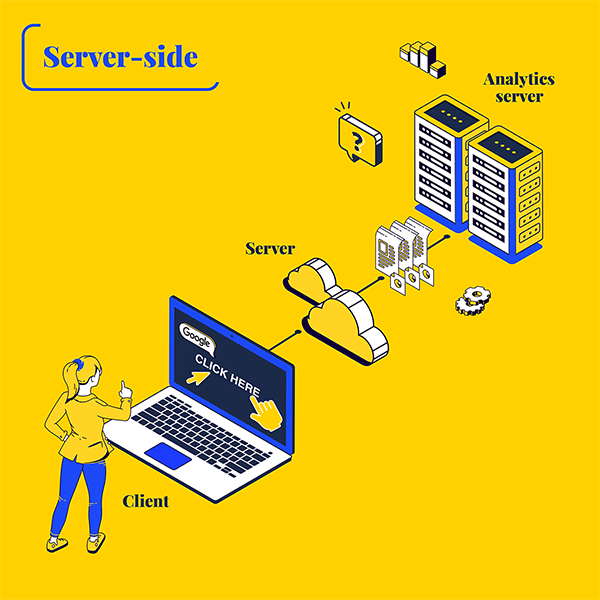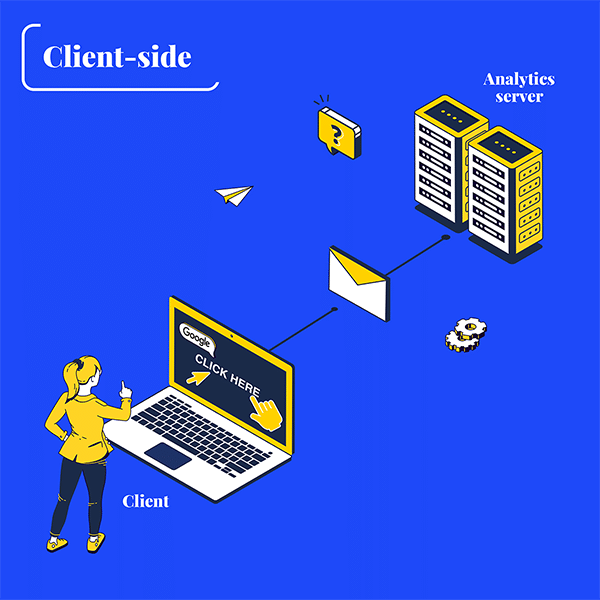Server side or client side: which tracking option is better for analytics?
The debate between server side versus client side tracking is more than a technical skirmish—it impacts data accuracy, privacy, user experience, and compliance.
Server side tracking offers enhanced security and data integrity by processing information on the server, away from the dead ends of ad blockers and stringent browser policies. On the other hand, client side tracking provides real-time data collection directly from the user’s device, enabling immediate insights and interactions.
This article will explore the definitions of server side and client side tracking, their advantages and disadvantages, and guidance on choosing the best method for your needs. By understanding these two approaches, you can make informed decisions that align with your strategic objectives and operational capabilities.
In this guide:
- Server side tracking collects and processes user data directly on a server, while client side tracking does most of this work on users’ devices.
- Client side tracking is easier to implement, but it can lead to data gaps, security concerns, and slower load times for users.
- While server side tracking takes more work to install, it improves marketing attribution, strengthens data security, and reduces payloads for users.
- Hybrid tracking combines client side and server side methods to deliver comprehensive, accurate data collection that captures detailed user interactions while avoiding browser limitations, though it requires careful technical coordination to prevent data duplication and ensure seamless integration.
What Is Server Side Tracking?
Server side tracking is a data collection method where user interactions are sent directly to a server, bypassing the client’s browser or device. It offers deeper insight and control over data processing and privacy.
Server side tracking captures and processes data from user interactions on websites or apps at the server level rather than relying on the client side (like the user’s browser).
This method allows for direct transmission of data from the source to the server, enabling more secure and robust data handling. By moving much of the data processing off the client, server side tracking provides a foundation for more accurate and comprehensive analytics.

Advantages of Server Side Tracking
Server side tracking enhances how businesses collect, analyze, and leverage user data. By centralizing the data collection process at the server level, you can achieve a high level of data accuracy and security.
Here are some key advantages:
- Enhanced Data Privacy and Security. By processing data server side, sensitive information is less exposed to vulnerabilities like browser-based attacks.
- Improved Data Accuracy. Server side tracking reduces data loss from ad blockers and browser restrictions on cookies, leading to more accurate and reliable analytics for decision-making. We’ve seen some companies capture around 25% more sessions and sales when they implemented server side tracking. This leads to improved ROI on ad campaigns, since session and conversion data is not lost.
- Better Site Performance. Offloading the data collection workload to the server lightens the load on the client side, resulting in faster page load times and a smoother user experience.
- Extended Data Retention. Server side tracking allows businesses to store data for longer periods, bypassing browser-imposed storage limits. This ensures access to historical data, enabling deeper analysis and more accurate long-term trends.
- Greater Flexibility in Integration. With server side solutions, data can be seamlessly integrated with various platforms and tools. This adaptability simplifies the tech stack and enhances workflow efficiency.
- Improved Attribution. By collecting and processing data at the server level, companies can achieve more precise attribution across channels. This means better understanding of customer journeys and optimizing marketing efforts.
- Reduced Dependency on Third-Party Cookies. Server side tracking minimizes reliance on third-party cookies by leveraging first-party data. This future-proofs your data strategy, ensuring consistency even as browsers phase out cookies.
Disadvantages of Server Side Tracking
Server side tracking is not without its challenges. Implementing and managing it requires understanding both the technology and data privacy laws, which can be a hurdle for many organizations.
Some key disadvantages include:
- Technical Complexity. Setting up and maintaining server side tracking can be complex and resource-intensive, requiring significant technical expertise and potentially higher upfront costs.
- Potential Data Integration Issues. Integrating server side tracking data with other sources can be challenging, potentially leading to data silos or integration headaches.
- Strict Data Privacy Regulations. With greater control over data comes the responsibility to comply with stringent data protection laws, which can vary widely by region and require careful navigation to avoid legal pitfalls.
- Storage Costs and Server Maintenance. Server side tracking requires data servers to receive and store data, which involves costs based on the volume of data. Servers also need to be maintained and kept up to date with functionality. There are some services that provide servers and upkeep to make this aspect of server side tracking easier. We’ve had great experience with Elevar.
- Reduced Visibility into Client Side Events. Server side tracking struggles to capture detailed client side interactions like clicks or mouse movements. This limits behavioral insights and often requires additional client side tools to fill the gap.
- Latency and Data Sync Challenges. Data transmission between servers and external systems can cause delays and inconsistencies, making real-time analytics less reliable and requiring careful management.
- Limited Access to Browser/Device Context. Server side methods lack granular details about browsers or devices, which are critical for customized experiences and debugging, potentially impacting optimization efforts.
Tips for Implementing Server Side Tracking
Transitioning to server side tracking can significantly improve your data’s accuracy, privacy, and actionable insights. However, navigating this shift requires careful planning and execution. Here are some practical tips to help you implement and maximize the benefits of server side tracking.
Here are essential steps to effectively implement server side tracking:
- Develop a tracking plan. Establish a clear and intuitive naming convention for all campaigns across your marketing channels and touchpoints, so that data is consistently structured and aggregatable.
- Integrate and centralize your data. Implement server side tracking for all digital channels and integrate it with other customer data (e.g., CRM and sales data) in a centralized data warehouse or analytics tool. Inadequate data integration can prevent a holistic view of customer interactions and hinder accurate attribution to all the touchpoints in the user journey- you could be missing a critical piece of the puzzle!
- Analyze and visualize data. Data collection is only as useful as far as the data is leveraged to inform strategic decisions. Plug your server side tracking data into a dashboard report that presents the wealth of data in a clean, direct, and easy-to-digest way. Scrutinize your metrics and pull out actionable insights.
- Test, learn, and optimize. Continuously improving (or even maintaining) performance requires taking actions based on data-driven insights. Confirm your assumptions and test your theories by conducting A/B testing, analyzing results, and adjusting your marketing mix accordingly. Push to constantly evaluate and enhance your marketing attribution strategy through testing, learning, and optimization
What Is Client Side Tracking?
Client side tracking is a method where data collection and processing occur within the user’s browser or device before being sent to servers. This approach is widely used for its simplicity and direct interaction with the user’s experience.
Client side tracking captures user interactions directly on their device, such as clicks, page views, and form submissions This data is then processed within the browser and subsequently sent to analytics servers for further analysis. It allows for real-time data collection and immediate feedback on user behavior, making it a staple in digital analytics.

Advantages of Client Side Tracking
Client side tracking stands out for its ease of implementation and its immediate access to user interaction data. This method allows marketers and website owners to quickly deploy tracking scripts and start collecting valuable data about how users interact with their digital properties.
Here are some notable advantages:
- Ease of Implementation. Setting up client side tracking is generally simpler and faster than server side alternatives, requiring only the inclusion of tracking scripts on web pages.
- Real-Time Data Collection. This method allows for the immediate capture and analysis of user actions, enabling dynamic responses and adjustments in real-time.
- Rich User Behavior Insights. Client side tracking offers detailed visibility into user interactions on a website or app, providing a wealth of data about user behavior and preferences.
- Easier Integration with Marketing Tools. Client side tracking works seamlessly with most third-party marketing and analytics platforms, thanks to the widespread compatibility of tracking scripts. This makes it simple to sync data with tools such as Google Analytics, advertising platforms, and CRM systems, ensuring streamlined operations.
- Lower Initial Cost Implementing client side tracking is generally more cost-effective upfront since it doesn’t require significant infrastructure changes. With no need for additional server resources, businesses can kickstart their data collection efforts on a budget.
Disadvantages of Client Side Tracking
Client side tracking also comes with limitations to data accuracy and user experience. Navigating these drawbacks requires a balanced approach to data collection strategies.
Some significant disadvantages include:
- Vulnerability to Ad Blockers. Many ad blockers and privacy tools can prevent client side scripts from executing, leading to gaps in data collection and analytics insights.
- Dependence on Browser Performance. Since processing occurs in the browser, heavy tracking scripts can slow down page load times and negatively affect user experience.
- Data Privacy Concerns. Collecting data from the client side can raise privacy issues, as it involves directly handling potentially sensitive information in the user’s browser, necessitating strict compliance with data protection regulations.
- Susceptibility to Data Loss Client side tracking relies on user devices and browser environments, making it vulnerable to interruptions like poor network connectivity or script failures. This can lead to incomplete or missing data, impacting the accuracy of your analytics.
- Shorter Cookie Lifespan Cookies set through client side tracking are subject to browser-specific policies and restrictions, including shorter expiration periods. This limits the time available to track user behaviors, affecting long-term data continuity and insights.
- Data Inconsistencies Since data is collected directly from the user’s device, variations in browser configurations and device types can result in inconsistent data. This lack of uniformity adds complexity to analysis and decision-making processes, reducing the reliability of insights.
Which Type of Tracking Is Best?
Ready to decide which method to use? You’ll need to consider your specific needs, technical capabilities, and privacy considerations. Both client side and server side tracking have their ideal use cases. The choice between them often hinges on the balance you wish to strike between ease of implementation, data accuracy, user experience, and privacy compliance.
Client Side Tracking: Easier to Implement
Client side tracking excels in scenarios where simplicity and speed are paramount. It’s particularly well-suited for small—to medium-sized businesses that may not have the resources for complex setups.
Client side tracking lets you deploy quickly, so you get immediate insights into user behavior without requiring extensive backend development. It’s ideal for real-time analytics, A/B testing, and personalizing user experiences based on immediate interactions.
However, you need to consider the limitations, especially regarding data accuracy and privacy issues, which can undermine the entire data collection project.
Server Side Tracking: Better for Marketing Attribution
For businesses prioritizing data accuracy, privacy, and comprehensive marketing attribution, server side tracking is the superior choice.
By moving data collection and processing to the server, you mitigate many of the drawbacks associated with client side methods, such as data loss due to ad blockers and browser restrictions. Server side tracking offers enhanced security and privacy, making complying with stringent data protection laws like GDPR and CCPA easier.
Server side tracking is especially valuable for companies with the necessary technical infrastructure and those dealing with large volumes of data. It facilitates a more accurate analysis of marketing campaigns across different channels and touchpoints, allowing for detailed attribution models that better reflect the customer journey.
This level of granularity and control is why we advocate server side tracking for our clients. It enables more strategic decision-making by providing a holistic view of how various marketing efforts contribute to conversions and revenue.
Implementing server side tracking requires a more substantial initial investment, both in terms of time and resources. But, the long-term benefits of improved data quality and reliability, enhanced user experience, and robust privacy compliance make it a worthwhile endeavor for businesses committed to collecting accurate data.
A Third Option: Hybrid Tracking
Hybrid tracking combines both client-side and server side methods to capture user data. This approach marries the ease and immediacy of client side tracking with the precision and security of server side tracking, creating a versatile framework for data collection and analysis.
Key Benefits of Hybrid Tracking
- Comprehensive Data Collection With both tracking methods, hybrid tracking ensures no critical data points are missed. Client side tools can capture detailed user interactions, while server side tracking handles data that might otherwise be blocked by ad blockers or privacy settings.
- Improved Accuracy Server side tracking avoids browser-based limitations, while client side methods provide real-time engagement insights. Together, they deliver more precise analytics and a clearer picture of user behavior.
- Scalability Hybrid tracking supports businesses as they grow. It allows for quick, codeless tracking during initial stages and integrates more robust, server-based capabilities as companies scale and require advanced analytics.
Challenges
- Implementation Complexity Combining client side and server side systems requires careful coordination and technical expertise. Event deduplication settings and procedures must be applied so that the hybrid tracking does not become duplicative tracking. To achieve seamless integration, businesses often need collaboration between IT and marketing teams.
Hybrid tracking offers a balanced path forward, allowing businesses to enjoy detailed insights without sacrificing precision, all while adapting to evolving data strategies.
Ready to elevate your marketing strategy with server side tracking? Begin by assessing your current data collection framework and consider how server side tracking can fit into your broader marketing goals. Remember, the path to data-driven success is an ongoing journey of refinement and optimization.





